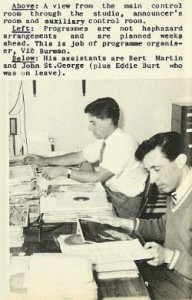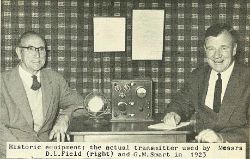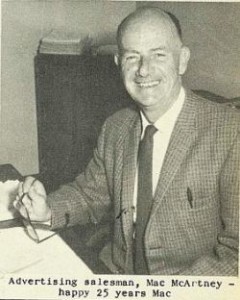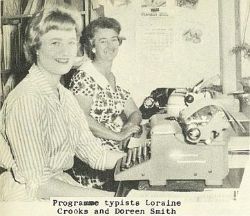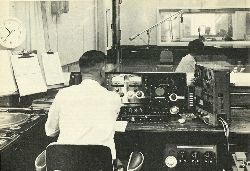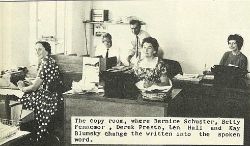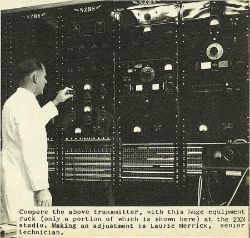 A personal reminiscence by Martin Hadlow
A personal reminiscence by Martin Hadlow
As a youngster growing up in Nelson, New Zealand in the 1950s and 60s, 2XN was our local radio station. In my youth, it was operated by the New Zealand Broadcasting Service (NZBS), later to become a Corporation (NZBC) and, in its next phase, Radio New Zealand (RNZ). Little was I to know, as I defied the instructions of my parents and listened surreptitiously to late-night radio dramas (such as Dick Barton-Special Agent) on 2XN while huddled under the blankets of my bed, that I would one day work at the station.
Interestingly, long before 2XN came into being, Nelson was the location of one of New Zealand’s pioneering radio experiments. As early as 1923, local identity Mr. D. Field established a radio station under the call-sign 2YA. According to local histories, the station operated without mains electricity but needed “300 torch batteries soldered together” to go on the air. The station broadcast from the Wilkins & Field Ltd. hardware shop in Hardy Street. It was one of those stores which sold everything, from a pin to an anchor, and I remember often cycling past the shop as a school boy and seeing the aerial array on the roof.
My first personal experience with actually being in the 2XN studios was when, as a primary school student, I participated once or twice in the daily school segment on the 2XN breakfast session. This five minute programme comprised a ‘live’ interview with a school student and then the playing of a piece of brass band music to ‘march us off to school’. The Chief Announcer, Ken Pritchard, was the host the days I was on-air and, many years later, I worked with him as a colleague.
In my secondary school days, I was again involved with 2XN through a weekly quiz programme sponsored by a local musical instruments shop. The host of the quiz was Alan Paterson, a part-time sports announcer and compere at 2XN. His regular job was in the insurance industry but, such was his on-air talent, he spent a great deal of time at the station in a variety of roles. The secondary school quiz ran over a period of weeks and I ended up as joint runner-up for the major prize, which was the grand sum of two guineas (two pounds and two shillings).
At the time, I was also beginning to develop a greater understanding of radio through the hobby of DXing, and my father and I would listen together to shortwave radio stations worldwide to gain verification letters and QSL cards. More than just an interest, radio was rapidly becoming an all-consuming passion and, in the same way youngsters today are involved with their computers, I listened to the radio for many hours each day. I would often go to bed with the sound of The Goon Show and any other number of favourite radio programmes in my ears.
The early-1960s were still the pre-Beatles ‘pop music’ era when teenagers were used to listening to older-style artists, while new musical trends and stars were just emerging. Each week, 2XN had a specific half-hour programme for people of my age, known as Teen Time. Interestingly, the programme was presented by a host who was Canadian, by nationality, but who worked on a daily basis as a shop assistant at Wilkins & Field Ltd., the very same store where radio had been born in Nelson 40 years previously. On the 2nd July, 1963, I won a prize on Teen Time and, with much excitement, pedalled my push-bike to the 2XN office to collect the prize. It was a 33 1/3 rpm long playing record (LP), known today as ‘vinyl’, produced by RCA Victor Records. The title was 12 Sides of John D. Loudermilk. When I listen to it now, I am amused to think that we young people thought this was ‘hip’ and so exciting! I probably would have preferred an Elvis Presley LP, but John D. Loudermilk was, after all, also an overseas star and a major US song-writer and singer in those times.
In the late 60’s, I returned to Nelson following a period in the United Kingdom, where, after ditching a student life at college, I worked in the London office of ‘pirate’ stations Radio England/Britain Radio. It was a hugely exciting period, which included regular visits to our ship anchored off the coast beyond the three-mile international limit, and my love of a media career was truly ignited. When returning to Nelson after the UK Government introduced legislation to silence the British off-shore stations, I successfully applied for a job with 2XN, and became an Assistant Programme Officer.
My immediate supervisor was the Programme Organiser, Vic Burman, while Doreen Smith was one of the ladies who typed up our ‘Daily Log’, the schedule of spoken-word programmes and music provided to the announcers in the studio and the technicians in the control room. In those days, not only did staff members have clearly defined functions, but those in the programme area didn’t use typewriters but prepared materials by hand, which ladies in the ‘typing pool’ then put to paper. How times have changed! Marjory Wilson was then a receptionist and Nev Pankhurst, our technician, played the commercials and spoken word programmes (then all on vinyl discs of varying sizes) into the on-air broadcasts. Betsy Walter, later to become the first woman elected to the Nelson City Council and, eventually, Deputy Mayor, was the ‘larger than life’ host of the weekly children’s programme and a progressive woman years ahead of her time. The on-air radio ‘stars’ of the day were John Blumsky, Johnny Shearer, Mike Coyle and Sylvia Monk, amongst others. (John Blumsky later went on to become the RNZ journalist sent to the Antarctic in 1979 to report on the Air New Zealand Mt. Erebus disaster.)
2XN had its transmitting station at Stoke, then a very rural area half-way between Nelson city and the neighbouring town of Richmond. It broadcast on a frequency of 1340 kilocycles and the 175 feet high tower was a well-known sight along the road between the two places. Unfortunately, later (after I had left the station to join NZBC stations elsewhere) the entire office and studios of 2XN, then located on the second floor of a building in the city, were destroyed by fire. A new building was constructed in Cathedral Square, just off Trafalgar Street. Later, the station changed its call-sign to 2ZN. It now operates as Newstalk ZB 1341 and is just one of many AM and FM radio stations servicing the Nelson listening market.
Note: the photos above and many more can be found on this Nelson Calling photo news page.


